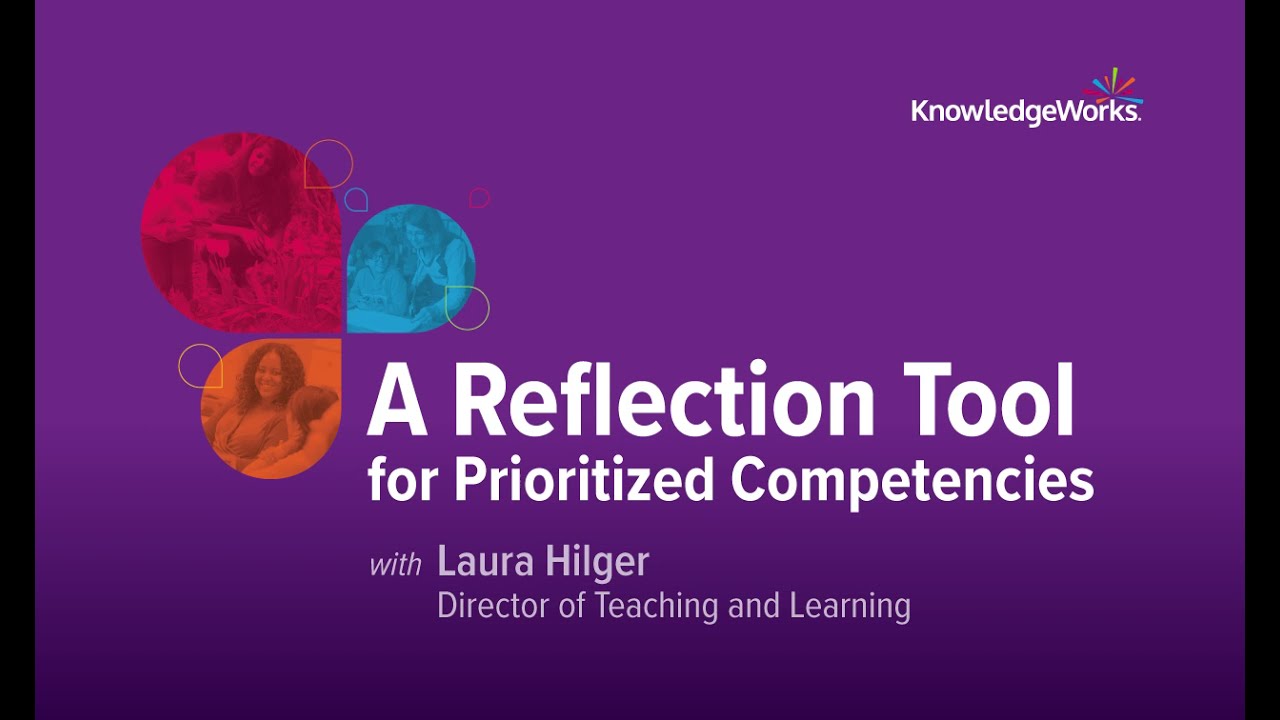Are you engaging with the revised edition of the Educator Competencies for Personalized, Learner-Centered Environments and ready to build your understanding of how your practices align to the indicators for each competency?
The Reflection Tool for Prioritized Competencies provides a guided approach with thoughtful questions designed to assist you in determining where you are in your learning journey towards mastering each competency – and can be adapted to suit your unique contexts and challenges, including with other competencies! Watch the video for an exploration of the tool and how to use it.

Transcript
Hey, everyone. My name is Laura Hilger, and I am a director of teaching and learning for KnowledgeWorks. I’m here today to talk to you about this Reflection Tool for Prioritized Competencies, which is one of the tools in our toolkit that we designed to accompany our Educator Competencies for Personalized, Learner-Centered Environments. To learn more about how we prioritize the competencies, please see the recording that is on that exact topic.
Today, I’m hoping that this recording will help you learn more about the purpose of this reflection tool, what it is, and how you might use it for your own professional practice. Now, in this introductory page here, you can see that it speaks to about a lot of different things for this reflection tool. A couple of things that I want to call out is that we have provided you with the operationalizing indicators for each of the competencies.
Operationalizing means that you have mastered the competency, and that you can defend with fidelity that you have mastered it. Alongside the indicators, we’ve also given you reflective questions and possible look fors to inform your reflection. Now, educators could use this tool in many ways, whether it is to journal, reflect, have collaborative discussions, and/or write an action plan for what they want to do next. What I want to emphasize is that, just like learners, adult learners are transitioning to personalized learner-centered environments in their own way. Everyone is on their own journey. And where they are, as far as implementing it, will differ.
And so, I invite you to personalize this tool based on where you are in your own implementation. I also want you to consider that the evidence you provide would also be personalized, but we want to make sure that we are able to defend where we are, so that we know, specifically, what we need to do next.
With that, I’m going to find an example: demonstrate a dedication to all learners, especially, those historically marginalized and are least served by public higher education, reaching college, career and civic readiness.
Below the competency, you’re going to see a table, and we have done this for all six of the competencies. The first column gives you those operationalizing indicators. And, as I stated earlier, these are the indicators that you will need to know and be able to do, and defend with fidelity in order to say that you’ve mastered that competency. So, for this competency, we have four indicators. I want you to take a minute and look at those, and maybe pick one that’s resonating with you. It could be one you’ve been working on a lot lately. You could pick one where you’re like, “That’s really new learning for me, and I want to start there.”
The next column is where we have given you the questions. Now, again, you might personalize these. You might pick one of the questions or all of them, but they’re meant to inform your reflection, so that you can journal, you can record, you can think to yourself about where you are in those indicators.
You will see you have a list of possible look fors. Now, I really want to call out a couple of things about these look fors. Please note it says, “Possible,” so this is not a checklist. This is not a must-do list. These are just possible examples that someone could provide to defend that they have met the indicator. For example, if you look down at that third one, examples of restorative justice being effectively used. It might be that a learning community is not using restorative justice, but they are using a method that is building their relationships and their learning culture effectively. And so, you would provide an example of that, rather than restorative justice.
If you look at that first one, personal active vision statement and aligned values. If you were to tell me that you have an active vision statement and aligned values, that means that your defense would include knowing that vision statement, being able to say it, being able to show me that you journal about that, you reflect about it, and you have evidence where you use your vision statement to inform your growth. So, again, those are possible look fors, and your look fors, your evidence of the indicators, might look different, those meant to help inform your reflection.
You will see that you have lines below the table, but you could choose to do some recording reflections, some walk and talks with a partner. You could get into teams and talk out these indicators and write down what your evidence would be. It is our hope that doing a reflective practice with these competencies will inform you at a deep level about where you are in your implementation, and what might be some next steps.
Explore the toolkit and many resources related to the Educator Competencies for Personalized, Learner-Centered Environments.


